David McFall R.A. (1919 - 1988)
Sculptor
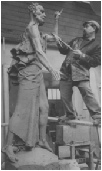
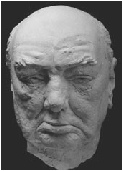
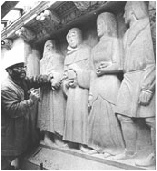
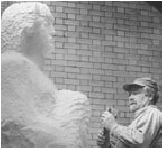

1956/11 Sir Jacob Epstein's Smuts statue - Lettering on plinth 
October 1956
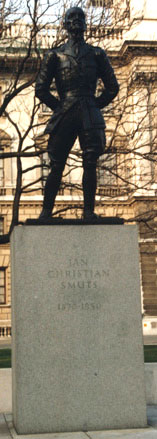
Jan Smuts was leader of South Africa for 14 years (1919-1924 and 1939-1948) and argued against the segregation of races (coining the terms ‘apartheid’ and ‘holistic’).
The statue in Parliament Square was unveiled on 7/11/1956.
The National Archive file opens with a note dated 7th May 1953 advising the First Commissioner Office of Works that the Smuts Memorial Committee had decided to recommend the appointment of Epstein as the sculptor. At that stage Epstein was 73 years of age. In a hand written note on this memo the First Commissioner says that he welcomes Mr. Epstein as the sculptor. We learn that Epstein is already working on a maquette and that the completed statue will be in bronze. An agreement was drafted undertaking to pay Epstein £10,000 for the work involved and a draft press notice was written. This confirmed the Minister of Works’ appointment of Epstein, said the work was expected to take about two years, and that the advisory committee who had recommend Epstein had been chaired by Lord Harlech, and that the members were Lord Methuen, The Rt.Hon. C.R. Attlee, M.P. The Rt.Hon. Clement Davies, M.P., Sir Kenneth Clark (former Director of the National Gallery), and Sir Percy Thomas, P.P.R.B.A.
At this stage the press release was put on hold as it was decided that the approval of the Royal Fine Art Commission should be sought. Epstein was sent the agreement on 8th July 1953. In July 1953 Harlech writes to the Minister of Works saying that he has seen two preliminary sketches by Epstein but was unhappy with them. Epstein asked for more photographs etc of Smuts so that he had a better feel for his subject. The press were now advised of the commission and there are various press cuttings in the file.
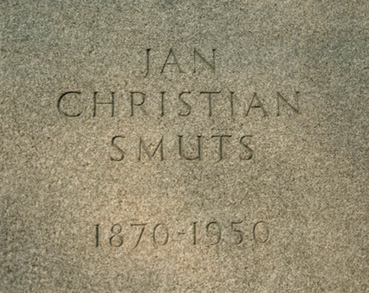
There was some concern expressed about Epstein’s appointment. One letter in the file reads ““but may I beg & implore you to see that his work may resemble & be a fitting representation of a very fine gentleman, instead of the grotesque, bulging, ugly statues that he (Epstein) usually makes”
In September 1953 the Royal Fine Art Commission, who had yet to see Epstein’s maquette, were writing about the suitability of Parliament Square as the site for the memorial and Harlech expressed the hope to the Minister of Works that the Royal Fine Arts Commission would not raise any serious objections to the site chosen.
Discussions regarding the site went on for some time, with a detailed replanning of the whole square being discussed , but the Royal Fine Arts Commission were still unhappy. It was not the subject of the memorial or indeed the choice of Epstein which was exercising their minds but the use of Parliament Square. They thought too many statues would detract from the Square’s overall appeal.
By June 7th 1954 Epstein was announcing that he wanted the committee to come to his studio to see Smut’s statue for which he had now produced a full size clay model and a meeting was fixed at Epstein’s studio at 18 Hyde Park Gate (no mention is made of the Royal Fine Art Commission seeing or approving the maquette but one assumes this had been done). The Clay model was well received by those committee members who could attend –Harlech, Clement Davies and Percy Thomas, as well as the Minister of Works and a Mr. Learey, However it was thought that Sir Kenneth Clarke and Clement Attlee, who had been unable to attend Epstein’s studio meeting should be given the chance to see the work.
On 30th July the Royal Fine Art Commission at last approved the siting and on 25th August 1954 Kenneth Clarke wrote accepting the merit of Epstein’s work “altogether I think Epstein should be warmly congratulated for the courage and wholeheartedness with which he has worked on this commission”.
Attlee subsequently gave his approval and the go ahead was given to proceed to the bronze casting stage and discussions were held on the pedestal.
All loose ends now appear to have been tackled, the pedestal having been the subject of protracted discussion and in October 1955 we read that the bronze had been cast, and in November Epstein was paid his final instalment of £4000, although the granite for the pedestal was still awaited from South Africa.
We then learn by a letter of 20th February, 1956 from Sinclair & Co in South Africa that the granite block for the pedestal had been damaged.
This caused further delays and we read from a short report in The Daily Telegraph that the bronze statue, now complete, was being stored in the Tate.
The unveiling was fixed for 7th November 1956. Winston Churchill was unwell so the Speaker of the House of Commons, W.S. Morrison, performed the task. There is a comprehensive report on the ceremony in the file.
The final letters on file concern the objections of Lord Brand to the statue . He writes on the 21st January 1960 expressing his dislike for the statue and suggesting it be removed. He says that at the unveiling he had turned to Lord Harlech and said “this is simply ghastly”. He says in his letter that he will raise the matter in the House of Lords. An internal Office of Works note then follows. There is little agreement with Lord Brand and the note finishes-“ Indeed it seems to me that Lord Brand would be singularly ill-advised to raise the matter in the House of Lords so soon after the sculptor’s death: I should expect that in such circumstances public opinion would rally strongly in defence of the sculptor’s memory”.
On 3rd February 1960 the file ends with a copy of the reply to Lord Brand which says “In all these circumstances, I am afraid I would not feel justified in taking away the statue”. Rather sadly the letter ends “Having said what I have thought it my duty to say to you, I must add the irrelevant comment that I greatly dislike the statue myself”. [http://yourarchives.nationalarchives.gov.uk/index.php?title=Epstein%2C_Sir_Jacob_(1880-1959)_Knight_sculptor ]
All rights reserved
| Animals |
| Busts and Heads |
| Children |
| Churchill studies |
| Lettering |
| Medals coins plates |
| Reliefs |
| Stone carvings |
| Contemporary British Artists |
| On Epstein |
| Picasso |
| The art of portrait sculpture |
| Letters |
| Palliser |
| Son of Man |
| Press |
| Obituaries |
| Memorial address |